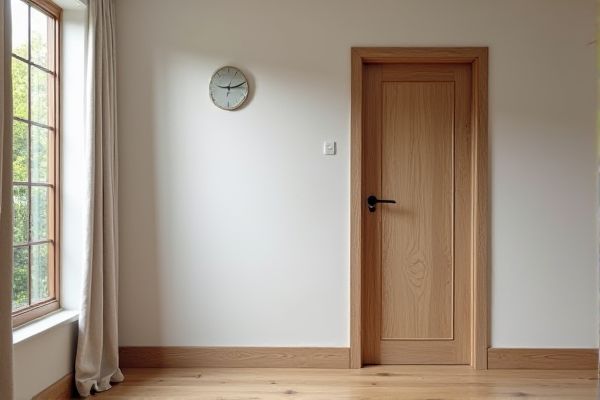
Pocket doors save space by sliding into the wall, making them ideal for small rooms or tight areas, while swing doors require clear floor space for opening and offer a more traditional look and feel. Explore the rest of the article to discover which door type best suits your home's design and functionality needs.
Table of Comparison
| Feature | Pocket Door | Swing Door |
|---|---|---|
| Space Efficiency | Maximizes space by sliding inside wall cavity | Requires clear swing area, uses more floor space |
| Installation | Complex; requires wall modification and framing | Simple; standard door frame and hinges |
| Cost | Higher initial cost due to materials and labor | Generally lower cost and easier to replace |
| Maintenance | Requires track cleaning; potential for sticking or misalignment | Minimal; hinges may need occasional lubrication |
| Accessibility | Good for narrow spaces; smooth sliding action | May hinder movement in tight areas due to swing radius |
| Design Options | Limited styles; concealed hardware | Wide variety of styles and hardware choices |
| Privacy & Soundproofing | Less effective sealing; moderate sound reduction | Better sealing and sound insulation with proper design |
Introduction: Pocket Door vs Swing Door
Pocket doors save space by sliding into the wall cavity, making them ideal for small rooms or tight areas where clearance is limited. Swing doors require floor space to open and close, which can restrict furniture placement and reduce usable room area. Choosing between pocket doors and swing doors depends on spatial constraints, aesthetic preferences, and installation complexity.
Space Efficiency Comparison
Pocket doors save significant floor space by sliding into wall cavities, making them ideal for small rooms or areas with limited clearance. Swing doors require a clear radius equal to their door width, which can reduce usable floor space and restrict furniture placement. In tight spaces, pocket doors maximize functionality and accessibility without compromising on room layout.
Installation Process and Requirements
Pocket doors require precise framing within the wall cavity, demanding additional space and structural modifications compared to swing doors. Installation involves mounting a recessed track and ensuring smooth sliding mechanisms, often necessitating professional carpentry expertise. Swing doors have simpler installation processes, needing just a door frame, hinges, and clearance for door swing, making them more adaptable to standard door openings.
Design and Aesthetic Options
Pocket doors offer a sleek, space-saving design by sliding discreetly into the wall cavity, making them ideal for modern interiors and small rooms. Swing doors provide a wide range of styles and materials, from traditional to contemporary, allowing more versatility in decorative elements like paneling and hardware. Both options can be customized with glass inserts, finishes, and colors to complement various architectural themes.
Durability and Maintenance
Pocket doors offer enhanced durability in spaces with minimal wear and tear, as their sliding mechanism is protected within the wall, reducing exposure to damage. Swing doors, while generally sturdy, require regular maintenance of hinges and alignment to prevent sagging and ensure smooth operation over time. Choosing between the two depends on factors such as usage frequency, environmental conditions, and ease of access for repairs.
Cost Analysis: Pocket Door vs Swing Door
Pocket doors typically cost more to install than swing doors due to the need for wall modification and specialized hardware, averaging between $1,000 to $2,500 compared to $300 to $1,500 for swing doors. Maintenance expenses for pocket doors are often higher because of track systems and potential alignment issues, whereas swing doors generally require less upkeep over time. When evaluating your budget, consider both initial installation and long-term maintenance costs to make the most cost-effective choice for your space.
Soundproofing and Privacy
Pocket doors offer less soundproofing compared to swing doors due to their design, which often leaves gaps between the door and the frame. Swing doors create a tighter seal when closed, significantly enhancing privacy and reducing noise transmission. For environments prioritizing soundproofing and privacy, swing doors are generally the more effective choice.
Accessibility and Ease of Use
Pocket doors enhance accessibility by sliding smoothly into the wall cavity, eliminating the need for clearance space and making them ideal for tight or confined areas. Swing doors require a clear arc for opening and closing, which can obstruct pathways and limit ease of movement, especially for individuals with mobility aids. The minimal effort needed to operate pocket doors improves usability for people with disabilities, whereas swing doors may present challenges due to their heavier weight and required pushing or pulling action.
Best Applications for Each Door Type
Pocket doors are ideal for small spaces, such as closets, bathrooms, and narrow hallways, where saving floor space is crucial since they slide into the wall cavity. Swing doors are best suited for rooms requiring wide openings and easy access, like living rooms and bedrooms, providing better sound insulation and a traditional aesthetic. Both door types serve specific functional needs: pocket doors excel in space conservation, while swing doors offer greater versatility in design and usage.
Conclusion: Choosing the Right Door for Your Space
Pocket doors maximize usable space by sliding seamlessly into walls, ideal for small rooms or areas requiring unobstructed floor plans. Swing doors offer classic functionality with ease of installation and greater sound insulation, suitable for traditional layouts and larger spaces. Selecting the right door depends on spatial constraints, aesthetic preferences, and the desired balance between functionality and style.
 homyna.com
homyna.com